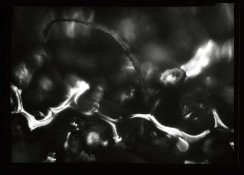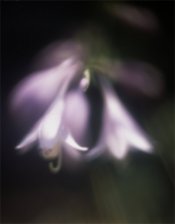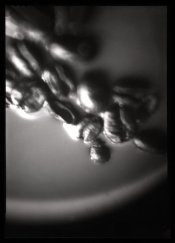For macro purposes, you can use lenses for 35mm and medium format cameras, as long as you have a way of controlling the aperture and physically mounting the lens to the camera.
David, all of these lenses have to be reversed for work above 1:1. I've tested and very occasionally use a 55/2.8 MicroNikkor for this. Reversed, attached to a #1 shutter with an SKGrimes adapter and with a Nikon BR-4 on the lens' mount. The BR-4 isn't really needed, the lens' best aperture in this application is f/4. I'm not familiar with other 35 mm or medium format systems but am confident that most of them have lenses etc. that can be used in the same way. FWIW, a poster on the French LF says that a 55/3.5 Nikkor does better in this application than an f/2.8er.
Most 4x5" cameras have 12-18" extension without adding extra standards and bellows (or using a larger, sturdier camera with a reducing back), so if you don't have lots of extension on your camera, you use a shorter lens. At a certain point there's a tradeoff between using a longer lens to get more distance between the lens and the subject and the inconvenience of working with a really long camera that might require two tripods.
Depends on the camera and system. One of the charms of square rail Cambos is that 1"x1" 80/20 brand t-slotted extrusions work perfectly well with square rail Cambo standards and are available up to 96" long at very low prices. For anything longer than around 48", though, two tripods are needed.
I shoot glass pieces, portions of the glass figurines at high magnification in either full frame digital or med format film. I want to be able to do the same thing in LF in order to have the ability to make really large prints. I work at around 2-5X magnification ratios in 35mm and about 4-7x in med format. I want to be able to get the same part of the figurine to fill the 4x5 or even an 8x10 frame.
Alexander, it sounds like you want to shoot at perhaps 15:1 on 4x5 and 30:1 on 8x10. The lenses typically used to get these magnifications have short focal lengths (12/1.9 Photar, 16/2.8 Luminar, 19/2.8 MacroNikkor) and will give you short working distances.
At these magnifications you'll need considerable extension; the magic formula is extension (more-or-less center of lens to film distance) = magnification * (1 + focal length). Depth of field will be nil with the lens wide open and stopping down will gain nothing of diffraction.
Focus stacking with a 24x36 chip digital SLR may be your best choice. Focus stacking with larger formats is physically possible but expensive and very hard to pull off. Think harder about what you really have to deliver before investing in specialized lenses for photomacrography and large format gear.


 . The calculator dial on the LunaPro-F made it all a hell of a lot easier.
. The calculator dial on the LunaPro-F made it all a hell of a lot easier.







